Hip flexors muscle Anatomy, Origin, Insertion, Function, Exercises
Table of Contents
Introduction
- A hip flexor muscle is a muscle that flexes the hip, ie bringing the knee closer to the chest. Hip flexion function is maximal with a high, forward kick that put forward the leg above the level of the waist. Every time you take a step, you are using the hip flexor muscles.
- They are important to maintain the posterior pelvic muscles in balance.
- A strong core muscle is one way to strengthen hip flexors and practice good posture.
- Stretching of these muscles will further increase their length & help prevent injury.
- The hip flexors include 5 key muscles that contribute to hip flexion: iliacus, psoas, pectineus, rectus femoris, & sartorius.
Prime movers
The prime movers (agonists) for hip flexion are the:
- Psoas major muscle is a long, fusiform muscle that arises at either side of the spine & inserts at the lesser trochanter of the femur. The psoas muscle contracts when the hip is flexion. The psoas minor muscle is a normal anatomic variant present in approximately 60% of people.
- Iliacus muscle. The iliacus muscle is a triangular sheet that joins the ilium bone to the lesser trochanter.
- The iliacus & psoas muscles are also grouped together as the iliopsoas musculotendinous unit secondary to overlapping action and anatomic proximity. The iliopsoas has an associated bursa that is the largest bursa in the body and is located between the iliopsoas & the hip capsule or pubis.
- These 2 muscles contribute to postural stability while standing erect & elevating the torso from a supine position.
- The iliopsoas muscle is the body’s main hip flexor. People who spend the majority of the day sitting down have shorter hip flexor muscles, tilting the pelvis,& can change how the person walks. See Sitting Ergonomics & The Impact on Low Back Pain
Synergists
- The rectus femoris muscle is one of the quadriceps & a hip flexor muscle and has 2 functions: flex at the hip; extend the knee. Rectus Femoris is engaged intensely when both actions are at play, such as when kicking a soccer ball & swinging a straight leg forward.
- The sartorius muscle, the longest muscle in the body, crosses the hip & the knee joints. It arises at the anterior superior iliac spine & inserts superficially on the pes anserinus as a broad fascial insertion. It acts to flex the hip, & secondarily to adduct the thigh & externally rotate the leg. Like with the Rectus Femoris muscle, great effort from Sartorius’s muscle is needed during a soccer kick, particularly when kicking across the body.
- The pectineus muscle acts as a hip flexor & secondary adductor from its origin on the superior pubic ramus & insertion on the pectineal line of the femur.
Iliopsoas muscle
Introduction
- The iliopsoas muscle is a compound muscle composed of the iliac & psoas muscles
- The iliopsoas muscle complex is made up of 3 muscles that include the iliacus, psoas major & psoas minor. This complex muscle system can act as a unit or intervene as separate muscles.
- The iliopsoas muscle is the strongest hip flexor & assists in the external rotation of the femur, playing the main role in keeping the strength & integrity of the hip joint. It is essential for correct standing or sitting lumbar posture, & during walking & running.
- The fascia covering the iliopsoas muscle creates more fascial connections, relating the muscle with different viscera & muscle portions.
- Many different problems may involve the iliopsoas. These conditions may cause pain, weakness, & difficulty with basic tasks such as walking, running, & rising up from a supine position.
Iliacus muscle
Introduction
- The iliacus muscle is shaped like a triangle, flat & an exact fit of the iliac fossa — the curved surface of the largest pelvic bone. Together with the psoas major muscle, it is also known as the iliopsoas muscle. A part of this muscle is attached to the iliac fossa, 2/3rd from its top. another portion is attached to the inside part of the iliac crest, the top, outer portion of the pelvic bone. Other fibers of the iliaccus muscle are attached to the iliolumbar & anterior sacroiliac ligaments (located at the base part of the sacrum) & up to the anterior iliac spine. iliacus muscle fibers then converge & insert on the tendon at the outer side of the psoas major muscle, which stretches from the lumbar spine in the lower back to the lower pelvis. many of these fibers extend to the femur bone or thighbone.
Origin
- Upper 2/3 of iliac fossa of ilium, internal lip of iliac crest, lateral aspect of sacrum, ventral sacroiliac ligament, & lower part of iliolumbar ligament
Insertion
- Lesser trochanter of femur. Its fibers are also inserted in front of those of the psoas major & extend distally over the lesser trochanter.
Structure
- The iliacus arises from the iliac fossa on the interior part of the hip bone, & also from the region of the anterior inferior iliac spine (AIIS). It connects the psoas major to form the iliopsoas. It begins across the iliopubic eminence through the muscular lacuna to its insertion on the lesser trochanter of the femur. iliacus fibers are also inserted in front of those of the psoas major & extend distally over the lesser trochanter.
Function
- The iliacus muscles flex & externally rotate the femur.
- It is also one of the key muscles that help to keep proper body posture.
- When combined with the psoas muscle the2 muscles are considered the strongest hip flexors in the body.
- It is also one of the key muscles that help to keep proper body posture.
- The Iliacus muscle can attach to an anterior tilt of the pelvis down & forward.
- Just like the iliacus, the iliopsoas is controlled for hip flexion. This muscle is also involved in trunk flexion, which is bending the trunk forward such as when you perform a sit-up & bend down to tie the shoes.
- The iliacus is also continuously active during walking but the psoas major is only active during gait shortly preceding & during the early swing phase.
- The iliacus muscle eccentrically controls the lateral side bending of the trunk.
Relations
- The anterior part of the pelvic portion of the iliacus muscle is covered with the iliac fascia, which split it from the peritoneum. This surface of the iliacus is also crossed by the lateral femoral cutaneous nerve, the cecum on the right side, & the iliac part of the descending colon on the left side. The medial margin of the iliacus muscle is in relation to the femoral nerve & lateral margin of the psoas major muscle.
- The anterior part of the thigh portion of the iliacus muscle is located posterior to the fascia lata, rectus femoris & sartorius muscles. It is crossed by the deep femoral artery. The posterior part of the iliacus is adjacent to the hip joint, from which it is split by a large subtendinous iliac bursa.
Nerve supply
- The iliacus muscle is innervated with nerves by the branches of the second & third nerves of the lumbar area through the femoral nerve. (L2, L3)
Blood supply
- Just like the psoas major muscle, the iliacus is innervated by the iliolumbar artery. It collects the blood from the deep circumflex iliac, obturator, & femoral arteries.
Assessment
Palpation
- The patient is supine with a pillow under the knees. Flex the knee & slightly laterally rotated Place palpating hand on the anterior iliac crest & palpate into the iliac fossa with the fingertips. Most of the iliacus is not palpable. Ask the patient to actively flex the thigh at the hip joint & feel for the contraction of the iliacus.
Tightness
- The patient stands against a wall, with heels apart, & shoulders & head touching the wall. Normal is the ability to posterior tilt to touch the small of the back as opposed to the wall. If the patient cannot posterior tilt by flattening their back onto the wall with the feet apart & the hips & knees straight, but can do so with knees bent & the hip flexed, the restriction might be shortened iliacus.
Psoas major muscle
Introduction
- The psoas muscle is a paraspinal muscle situated deep in the body, very close to the spine & the brim of the lesser pelvis. At its distal end, it connects with the iliacus muscle to form the iliopsoas muscle. This depth, combined with the fact that the psoas originates from the sides of the 5 lumbar vertebrae, means it plays an important role in back health.
- It also works to both laterally flex the lumbar spine as well as stabilize & flex the thigh.
- It is essential for correct standing & sitting lumbar posture, stability of the hip joint, & during walking & running
Origin and insertion
Psoas major is a long muscle situated immediately lateral to the vertebral column. It has an origin from the:
- Transverse processes of all the lumbar vertebrae
- Vertebral bodies of T12 to L5
- Intervening intervertebral discs
- The fibers of the psoas major extend inferolateral between the lesser pelvis towards the thigh. They pass along the pelvic brim & inferior to the inguinal ligament towards their merged insertion in the anterior thigh. Along its course, the lateral-most fibers of the psoas major muscle fuse with the fibers of the iliacus muscle to form the iliopsoas muscle. Iliopsoas passes deep to the inguinal ligament & anterior to the joint capsule of the hip to insert onto the lesser trochanter of the femur.
Structure
- The psoas major is divided into a superficial & a deep part. The deep part arises from the transverse processes of lumbar vertebrae L1 to L5. The superficial part arising from the lateral surfaces of the last thoracic vertebra, lumbar vertebrae L1–L4, & the neighboring intervertebral discs. The lumbar plexus is located between the 2 layers.
- Together, the iliacus muscle & the psoas major form the iliopsoas, which are surrounded by the iliac fascia. The iliopsoas muscle runs across the iliopubic eminence through the muscular lacuna to its insertion on the lesser trochanter of the femur. The iliopectineal bursa separates the tendon of the iliopsoas muscle from the external part of the hip-joint capsule at the level of the iliopubic eminence. The iliac subtendinous bursa is situated between the lesser trochanter & the attachment of the iliopsoas.
Variation
- In fewer than 50 % of human subjects, the psoas major muscle is accompanied by the psoas minor muscle.
Function
The psoas major muscle functions include:
- To connect the upper body to the lower body, the outside to the inside, the appendicular to the axial skeleton, & the front to the back, with its fascial relationship.
- Combined with the iliopsoas muscle, the psoas is a major contributor to the flexion of the hip joint in a supine position or standing.
- Stabilizes the lumbar spine during sitting.
- Work as a stabilizer of the femoral head in the hip acetabulum in the 1st 15 degrees of motion.
- Unilateral contraction of the psoas also helps with lateral motions & bilateral contraction can help elevate the trunk from the supine position.
- The psoas muscle also acts in conjunction with the hip flexors to elevate the upper leg towards the body when the body is static & pull the body towards when the leg is fixed.
- The psoas muscle is also 1 of the core muscles.
Relations
- Superiorly, the psoas major lies posterior to the diaphragm. The Quadratus lumborum is situated lateral to the muscle. In the abdomen, the psoas major is closely connected to a number of retroperitoneal structures. The inferior vena cava is situated medial to the right psoas major muscle. On the left, the abdominal aorta is located medial to the psoas major. The sympathetic trunk & aortic lymph nodes are also situated medially. Other retroperitoneal structures related to the muscle are the kidneys &ureters, the gonadal vessels & the genitofemoral nerve.
- Because of its place immediately lateral to the vertebral column, the roots of the lumbar plexus are embedded in the belly of the psoas major as they exit the vertebral canal. The plexus forms in the muscle with its branches appearing from its lateral border.
- In the thigh, the psoas major contributes to the ground of the femoral triangle. Its tendon iliopsoas tendon is situated deep in the fascia lata, sartorius, rectus femoris & deep femoral artery. It is from the joint capsule of the hip by the iliac bursa. Pectineus & the femoral vein are medial periods the femoral nerve is lateral to the muscle.
Blood supply
- The psoas major muscle is innervated mainly by the iliolumbar branch of the internal iliac artery. The lumbar branches of the aorta or the obturator branch of the internal iliac artery & also branches of the external iliac &femoral arteries contribute to the blood supply
- Venous drainage of the psoas major mirrors the arterial supply. It drains back into the femoral or external iliac & internal iliac veins & also directly into the inferior vena cava.
Nerve Supply
- Branches from the ventral rami of lumbar spinal nerves (L1, L2, & L3) prior they join to form the lumbar plexus. The lumbar plexus is implanted within the Psoas major muscle & its branches emerge from it.
Psoas minor muscle
Introduction
- The psoas minor muscle is a thin, paired muscle of the posterior abdominopelvic portion. It is situated on the anterior part of the psoas major muscle but does not extend with it beyond the inguinal ligament. Despite its close relation to the psoas major muscle, the psoas minor is not considered a portion of the iliopsoas muscle complex.
- The psoas minor is an inconsistent muscle, found only in a certain portion of the population. When present, it works on the lumbar spine to produce a weak flexion of the trunk.
Origin & insertion
- The psoas minor muscle originates from the lateral aspect of the bodies of the T12 & L1 vertebrae, as well as the intervertebral disc found between them.
- The muscle then extends inferiorly & tapers into a long, flat tendon, which is often longer than the muscle belly.
- The tendon inserts onto the pecten pubis pectineal line of pubis & the iliopubic eminence via a thickened band of fascia called the iliopectineal arch.
Structure
- The psoas minor muscle arises from the vertical fascicles inserted on the last thoracic & 1st lumbar vertebrae. From there, it passes down onto the medial border of the psoas major, & is inserted into the innominate line & the iliopectineal eminence. Additionally, it attaches to & stretches the deep surface of the iliac fascia & occasionally its lowermost fibers reach the inguinal ligament. It is posterolateral to the iliopsoas muscle. Variations happen, however, & the insertion on the iliopubic eminence many times radiates into the iliopectineal arch.
- The psoas minor muscle receives oxygenated blood from the 4 lumbar arteries inferior to the subcostal artery & the lumbar branch of the iliolumbar artery.
Function
- The psoas minor is a very weak muscle & its absence does not result in any reduced functionality of the body, thus its exact function is not entirely clear. However, it is suggested that it assists in trunk flexion, allowing a person to bend forward at the lumbar spine.
Relations
- The psoas minor muscle is situated entirely on the anterior surface of the psoas major muscle & thus shares a lot of its anterior relations. The right psoas minor sits posterior to the inferior vena cava & is crossed by the most distal end of the ileum, while the left psoas minor is crossed by the colon.
- Along its anteromedial border, the muscle is related to the sympathetic trunk & the aortic lymph nodes.
Nerve supply
- The psoas minor muscle is supplied by direct branches of the lumbar spinal nerves.
Variation
- The psoas minor muscle is considered inconstant & is also absent, only being present in 40% of human specimens studied. It has an average length of about 24 cm, of which about 7.1 cm is muscle tissue & about 17 cm is a tendon.
Blood supply
- The vascular supply of the psoas minor muscle comes importantly from the lumbar arteries. However, it also receives many minor contributions from the blood supply network of the psoas major muscle. This may add branches of the iliolumbar, obturator, external iliac & femoral arteries.
Pectineus muscle
Introduction
- The pectineus is a flat muscle found in the superomedial part of the anterior thigh. The fascial part of the thigh muscles is specific in that each of them is innervated by a femoral nerve (L2, L3). Due to having a dual nerve supply, the pectineus is one of a few muscles classified into 2 compartments simultaneously: anterior & medial. The others are adductor longus & adductor Magnus.
- For didactic purposes, the pectineus is usually described together with the 5 muscles of the medial compartment of the thigh. Namely, these muscles are the gracilis, adductor longus, adductor brevis & adductor Magnus. This muscle comprises the functional group of the Hip adductors muscle.
- Besides adducting the thigh, the functions of the pectineus consist of the additional movements of thigh flexion, external (lateral) rotation & internal (medial) rotation. Apart from being a prime mover, the pectineus is also a postural muscle as it stabilizes the pelvis & balances the trunk on the lower extremity during walking.
Origin of Pectineus muscle
- pectineal line & adjacent bone of the pelvis
Insertion
- the oblique line extending from the base of the lesser trochanter to linea aspera on the posterior surface of the femur.
Nerve supply :
- The pectineus is predominately supplied by the femoral nerve (L2, L3). However, in some people pectineus may receive innervation from 2 separate nerves of the lumbar plexus.
- This composite innervation reflects the dual compartmentalization of the pectineus into both the anterior & medial compartments of the thigh. In these cases, the anterior part of the muscle sits is supplied by the femoral nerve (L2, L3), a feature of muscles of the anterior thigh. While the posterior, smaller part of the muscle is innervated by a branch of the obturator nerve (L3, L4), the accessory obturator nerve.
Blood supply
- The superficial portion of the muscle is supplied by the medial circumflex femoral artery, a branch of the femoral artery. The deep part of the muscle is vascularised by the anterior branch of the obturator artery, itself a branch of the internal iliac artery.
Function
- Due to the course of its fibers, the pectineus both flexes & adducts the thigh at the hip joint when it contracts. When the lower limb is in the anatomical position, contraction of the muscle first causes flexion to happen at the hip joint. This flexion can go as far as the thigh at a 45-degree angle to the hip joint.
- At that point, the angulation of the fibers is such that the contracted muscle fibers pull the thigh toward the midline, producing thigh adduction. An example of a sequential movement that involves both actions of the pectineus muscle is crossing your legs at the knee or ankle. Hip flexion solely is an action that, in synergy with the psoas major, iliacus, rectus femoris & sartorius, enables the carry-through phase of the gait cycle.
- Some sources also state that the pectineus muscle contributes to the external & internal rotation of the thigh. This is still heavily debated, although it is noted that the insertion of the pectineus is lateral to the midline, beyond the mechanical axis of rotation of the femur, suggesting that there might be some merit to the argument.
- Besides being the prime mover, this muscle is also important to stabilize the pelvis. In fact, it is suggested that all the muscles attaching between the pelvis & proximal femur act as adaptable ligaments of the hip joint, preserving its integrity during body movements.
Structure
- The pectineus muscle arises from the pectineal line of the pubis & to a slight extent from the surface of the bone in front of it, between the iliopectineal eminence & pubic tubercle, and from the fascia covering the anterior surface of the muscle; the fibers pass downward, backward, & lateral, to be inserted into the pectineal line of the femur which conducts from the lesser trochanter to the linea Aspera.
Relations
- The muscle lies in the same plane as, & medially to, the adductor longus. While laterally, it is related to the psoas major muscle & the medial circumflex femoral artery & vein.
- The anterior surface of the pectineus forms the medial part of the floor of the femoral triangle together with the adductor longus, while the iliacus & psoas major complete the lateral side of the ground. This surface of the pectineus is covered with the deep layer of fascia lata that separates it from the femoral artery, femoral vein & great saphenous vein that courses through the femoral triangle.
- Posterior to pectineus are the adductor magnus, adductor brevis & obturator externus muscles, & the anterior branch of obturator nerve. The fascia lata peripherally bounds the anterior & posterior thigh compartments. These 2 are internally separated by medial & lateral intermuscular septa that attach to the femur. Although the adductor (medial) compartment to which the pectineus belongs does not have its own fascial border to separate it from the anterior & posterior compartments, it is still described separately due to the common function & muscular innervation of its constituents.
Rectus femoris muscle
Introduction
- The Rectus femoris muscle is a fusiform shape & is included in the quadriceps muscle. It is a bulk of muscle situated in the superior, anterior middle compartment of the thigh & is the only muscle in the quadriceps group that crosses the hip.
- It is superior & overlying of the vastus intermedius muscle & superior-medial portion of Vastus lateralis & Vastus medialis.
- The word rectus is a Latin word that suggests straight. Thus the rectus femoris is its name because it runs straight down the thigh.
- It is a 2-way acting muscle as it crosses over the hip & knee joints; therefore, it functions to extend the knee & also assists iliopsoas in hip flexion. It is also a hip flexor muscle.
- A short rectus femoris may give to a higher-positioned patella in relation to the contralateral side. A markedly shortened rectus femoris muscle is suggested by knee flexion of less than 80°or by clear prominence of the superior patellar groove.
Origin
- Rectus femoris muscle arising from the anterior inferior iliac spine(AIIS) & the portion of alar of ilium superior to the acetabulum.
- It has a proximal tendinous complex which is represented by a direct tendon, an indirect tendon, & a variable third head. Direct & indirect tendons finally meet into a common tendon.
- There is a membrane that attaches the CT to the anterior superior iliac spine.
Insertion
- Rectus Femoris muscle together with vastus medialis, vastus lateralis & vastus intermedius joins the quadriceps tendon to insert at the patella & tibial tuberosity through the patellar ligament.
Structure
- It originates from two tendons: one, the anterior or straight, from the anterior inferior iliac spine; and the other, the posterior or reflected, from a groove above the rim of the acetabulum.
- The 2 unite at an acute angle & spread into an aponeurosis that is prolonged downward on the anterior surface of the muscle, & from this, the muscular fibers arise.
- The muscle ends in a broad & thick aponeurosis that occupies the lower 2/3rd of its posterior surface, &, gradually becoming narrowed into a flattened tendon, is inserted into the base of the patella.
Function
- The rectus femoris muscle, sartorius muscle,& iliopsoas are the flexors of the thigh at the hip. The rectus femoris muscle is a weaker hip flexor when the knee is extended because it is already shortened & thus suffers from active insufficiency; the action will recruit more iliacus muscle, psoas major muscle, tensor fasciae latae, & the remaining hip flexors than it will the rectus femoris.
- Similarly, the rectus femoris muscle is not dominant in knee extension when the hip is flexed since it is already shortened & thus suffers from active insufficiency. In essence: the function of extending the knee from a seated position is primarily driven by the vastus lateralis, vastus medialis,& vastus intermedius, & less by the rectus femoris.
- On the other extreme, the muscle’s ability to flex the hip & extend the knee can be compromised in a position of full hip extension & knee flexion, due to passive insufficiency.
- The rectus femoris muscle is a direct antagonist to the hamstrings muscle, at the hip & the knee.
Relations
- The proximal portion of the rectus femoris muscle is located deep in the tensor fasciae latae, sartorius & iliacus muscles. All the contents of the anterior compartment of the thigh are located deep in the rectus femoris. These include the capsule of the hip joint, vastus intermedius, anterior margins of vastus lateralis & vastus intermedius, lateral circumflex femoral artery & some branches of the femoral nerve.
Nerve supply
- The neurons for voluntary thigh contraction arise near the summit of the medial side of the precentral gyrus (the primary motor part of the brain).
- These neurons send a nerve signal that is carried by the corticospinal tract down the brainstem & spinal cord. The signal is initiated with the upper motor neurons carrying the signal from the precentral gyrus down through the internal capsule, through the cerebral peduncle, & into the medulla. In the medullary pyramid, the corticospinal tract decussates & becomes the lateral corticospinal tract. The nerve signal will resume down the lateral corticospinal tract until it reaches spinal nerve L4. At this part, the nerve signal will synapse from the upper motor neurons to the lower motor neurons. The signal will travel through the anterior root of L4 & into the anterior rami of the L4 nerve, leaving the spinal cord via the lumbar plexus. The posterior branch of the L4 root is the femoral nerve. The femoral nerve is supplied by the quadriceps femoris, a 4th of which is the rectus femoris. When the rectus femoris receives the signal that has traveled all the way from the medial side of the precentral gyrus, it contracts, extending the knee & flexing the thigh at the hip.
Blood supply
- The rectus femoris muscle is supplied by the artery of the quadriceps, which can stem from 3 sources; femoral, deep femoral & lateral circumflex femoral arteries. The lateral circumflex femoral & superficial circumflex iliac arteries also contribute to the blood supply of rectus femoris, but to a lesser extent.
Assessment
Palpation
- Rectus femoris muscle can be palpated as it is the most superior of the quadriceps muscles. initial palpation at the anterior inferior iliac spine, rectus femoris muscle can be felt until its insertion into the quadriceps tendon. Asking the person to isometrically contract the quadriceps muscle will help to identify the muscle belly.
Strength
- To assess muscle strength for the Rectus Femoris including the rest of the quadriceps group muscle position the patient is sitting with the hip &knee flexed to 90° for grades 5, 4 & 3 while grade 2, is assessed in side-lying with test limb uppermost & the knee flexed to 90° position.
Other Tests
In Rectus femoris injury :
- Ely’s test – illicit pain on the tightness
- FABER (Patrick’s test) – illicit no pain
- Pain is felt in resisted hip flexion
- Knee ROM is reduced below 80° in shortness of Rectus femoris & prominence of patella grove is noted.
Sartorius muscle
Introduction
- You have a sartorius muscle on the sides of the body, each starting on the anterior superior iliac spine of the pelvis. From its start, the sartorius then crosses the front of the thigh, angling inward, ultimately ending on the medial side of the tibia.
- Because the sartorius runs through the two joints-the hip and the knee-the muscle plays a role in motion at both joints. The actions of the sartorius involve:
- Hip flexion: Flexing at the hip, as when a person marches in place with high knees
- Hip abduction: Dragging your leg away from your midline, as when you draw a step to the side
- External hip rotation: Rotating the leg outside so the thigh, knee, & toes turn toward the side of the room
- Knee flexion: Flexing the knee to move the heel toward the glutes
- The tree poses in yoga are an example of an exercise that needs all of the sartorius actions. When you do a tree pose, you have to flex the hip & knee to move the foot upward.
- You then have to abduct & rotate the hip outward of the room to put the bottom of the raised foot on the inside of the stationary leg. Cross-legged sitting is also the best example of sartorius muscle action.
Origin & insertion of Sartorius’s muscle
- The sartorius muscle originates from a round tendon from the anterior superior iliac spine & the upper half of the notch between the anterior superior iliac crest & the anterior inferior iliac spine. The fibers form a thin, flat muscle, which extends anteromedially across the anterior surface of the thigh.
- The muscle descends in an almost vertical fashion through the medial side of the thigh. It crosses the medial side of the knee joint & then inserts onto the medial side of the proximal tibia, anterior to the gracilis & semitendinosus muscles.
- The inserting tendons of these 3 muscles form a wide aponeurotic sheath known as the pes anserinus. Some fibers from the inferior portion of the tendon blend with the medial collateral ligament of the knee joint, & the deep fascia over the medial aspect of the leg, while some superior fibers merge with the knee joint capsule. These connections give to the medial stability of the knee joint.
Structure of Sartorius’s muscle
- The sartorius muscle arises from the anterior superior iliac spine, & the part of the notch between the anterior superior iliac crest & anterior inferior iliac spine. It runs obliquely across the upper & anterior portion of the thigh in an inferomedial direction.
- It passes behind the medial condyle of the femur to end in a tendon. This tendon curves anteriorly to join the tendons of the gracilis & semitendinosus muscles in the pes anserinus, where it inserts into the superomedial surface of the tibia.
- Its upper part forms the lateral border of the femoral triangle, & the point where it crosses the adductor longus marks the triangle’s apex.
- Deep to the sartorius & its fascia is the adductor canal, through which the saphenous nerve, femoral artery & vein, & nerve to vastus medialis pass.
The function of Sartorius’s muscle
- At the hip it flexes, weakly abducts, & rotates the thigh laterally. At the knee, it can flex the leg; when the knee is flexed, it also turns the leg medially.
- This muscle plays a central part in the stabilization of the pelvis—especially in women. This is due to the constrictive affect the muscles on both sides of the body have on the pubic symphysis.
Relations
- The sartorius muscle is located superficially in the thigh, with only fascia & skin over its surface. Deep to the sartorius muscle is the quadriceps femoris muscle.
- As it crosses from the lateral to the medial side of the thigh, the sartorius muscle crosses the surfaces of the iliopsoas, pectineus & adductor longus muscles. The tensor fasciae latae muscle arises just lateral to the proximal attachment of the sartorius muscle.
- The medial edge of the sartorius forms the lateral border of a main anatomical space called the femoral triangle. The triangle is completed superiorly by the inguinal ligament & medially by the medial margin of the adductor longus muscle. The structures found within the triangle, the femoral artery, vein & nerve, therefore, lie medial to the sartorius. The femoral artery resume inferiorly, deep to the sartorius.
Nerve supply
- Like the other muscles in the anterior compartment of the thigh, the sartorius is supplied by the femoral nerve.
Variation
- It may arise from the outer end of the inguinal ligament, the notch of the ilium, the ilio-pectineal line, or the pubis.
- The muscle may be split into 2 parts, & one part may be inserted into the fascia lata, the femur, the ligament of the patella, or the tendon of the semitendinosus.
- The tendon of insertion may end in the fascia lata, the capsule of the knee joint, or the fascia of the leg.
- The muscle may be absent in some people.
Blood supply
As sartorius is such a long muscle, it comes as no surprise that it needs extensive vascular supply from several sources:
- The proximal 3rd may receive its vascular supply from the branches of the femoral, deep femoral, lateral circumflex femoral arteries & or artery of quadriceps (branch of either the femoral, deep femoral, & lateral circumflex femoral artery).
- The middle 3rd is supplied by branches of the femoral artery.
- The distal 3rd receives blood supply from the femoral artery & descending genicular artery.
Clinical Anatomy
Pectineus muscle strain
- The most general symptoms of an injured pectineus muscle are pain, bruising, swelling, tenderness,& stiffness. Pain in the front hip site can mean that you may have strained the primary hip flexor muscles or the hip adductor muscles, or a combination of the two.
- When overstretched, a pectineus strain is possible. Pectineus pain can be caused in several ways:
- Changing directions suddenly or fastly
- Having legs crossed for extended periods of the time
- Fast movements from kicking or sprinting
- Overstretching a leg or both legs to the side of the body
- Striding too long during running or power walking
- Exercising with exertion after the pectineus muscle is the already fatigued legs splint/cast, foot/ankle problems, sudden overload due to gymnastics, football/ice skating injury, horse riding, skiing, cross-legged sitting, leg length discrepancy. Persistent “internal” groin pain, groin strain, hip pain, post-hip-replacement rehabilitation, post-hip fracture, pregnancy, postpartum, pain during sexual intercourse/ hip adduction exercises (gym), osteoarthritis of the hip.
- Due to the attachment of the pubis and the femur on the medial (or middle) part of the thigh, the straining of the groin muscles can cause soreness & pain in the entire portion on the inside of the thigh. Soreness from the tendon or muscle at the top or superior end of the muscle will be situated at the very top of the inner thigh near the pubic region. Soreness from the tendon or muscle at the bottom or inferior end of the muscle will be situated down the side of and deeper into the thigh.
- Once injured, the pain will result from lifting the thigh straight out in front of the body. Pain will also be felt as the groin muscles are stressed as the thighs are widened outward.
- The pectineus muscle can be injured by overstretching; specifically, by stretching a leg or legs too far out to the side or front of the body. Pectineus injuries can also be caused by rapid movements like kicking or sprinting, changing directions too fastly while running, or even sitting with a leg crossed for too long.
Rectus femoris Strain
- Rectus femoris muscle strain, referred to as hip flexor strain, is an injury generally at the tendon that attaches to the patella or in the muscle itself. The injury is commonly a partial tear but could be a full tear. The injury is caused by a forceful motion related to sprinting, jumping, or kicking & is common in sports like football or soccer. The rectus femoris muscle is prone to injury since it crosses both the knee & the hip. Symptoms include a sudden sharp pain at the front of the hip or in the groin, swelling & bruising, & an inability to contract the rectus femoris muscle with a full tear.
Avulsion fracture
- The Rectus femoris muscle-tendon can cause a fragment of the anterior inferior iliac spine of the hip (AIIS) to avulse in what is called an Avulsion fracture. An avulsion fracture is due to the forceful contraction of the muscle that generates a force greater than that which holds the bone together. This is a well-recognized, but uncommon sports injury that can affect young athletes.
- One of the many conditions that can disrupt the use of the sartorius muscle is pes anserine bursitis, an inflammatory condition of the medial portion of the knee. This condition usually happens in athletes from overuse & is characterized by pain, swelling, and tenderness.
- The pes anserinus involves the tendons of the gracilis, semitendinosus, and sartorius muscles; these tendons attach to the anteromedial portion of the proximal tibia. When inflammation of the bursae underlying the tendons happen, they separate from the head of the tibia. If the inflammation is overseen & poorly treated (rest, cooling, pain medication, local corticoid injection if necessary) bursitis often becomes chronic.
Anterior Superior Iliac Spine (ASIS) Avulsion
- Young athletes are permitted to ASIS avulsion injuries through the physis. These injuries typically happen secondary to indirect trauma via a sudden, forceful contraction of the sartorius muscle, along with the tensor fascia lata. The ossification of the apophysis usually does not happen until ages 21 to 25. Prior to this ossification happening, there is a weak point at the muscle-tendon-bone interface, which permitting to an avulsion. This generally occurs while the hip is in an extended position, like sprinting and swinging a bat
- Avulsions of ASIS is most often treated conservatively. This involves rest, stretching, protected weight-bearing with the aid of crutches, & the early commencing of range of movement exercises. There are indications, for operative treatment of this injury. If there is a displacement of the piece, there is a risk of irritation, and loss of strength, as well as healing of the part in a displaced position if the injury is treated by conservative means.
- Open reduction internal fixation (ORIF) is specified when the avulsion of the ASIS displaces by a distance of more than 2-3 centimeters. Painful non-unions are also an indication of surgical fixation. There are many different options, including the lag screw & the tension band fixation.
Sartorius muscle strain:
- Musculus sartorius is an upper leg muscle that has an origin at the spine iliaca anterior superior of the pelvic bone, it down diagonally along the whole length of the femur & then connects to the proximal medial portion of the tibia. It is the longest muscle on the human body & its function is knee flexion, but it also has a synergistic role with the internal rotation of the hip. It is commonly called the tailor muscle, due to the fact that it is active in a position that is very general for this profession, ie. when the legs are crossed with one leg going over the other, the muscle. the sartorius muscle is active during the movement of crossing the legs & it can also very often lead to problems if this position & movement is perpetuated continuously.
- Injuries or damage to the sartorius muscle can lead to pain & problems in the groin & the hip region, due to the simple fact that its origin is in that part. Sartorius muscle strain can lead to difficulties during daily activities such as walking, getting dressed & sports activities. A strained sartorius occurs when during a movement anterior upper leg musculature gets overly extended & excessive loads are put on it leading to the muscles, along with the sartorius muscle getting overstretched. Smaller & bigger muscle fiber ruptures can also happen when the muscle gets strained & overstretched.
Sartorius muscle tendonitis:
- Tendonitis causes Sartorius muscle pain & limited mobility of the muscle. You may feel pain in the front of the hip while flexing & rotating it during walking. Therapy may help decrease the inflammation of the muscle & improve its ability to contract properly to help you regain mobility.
Sartorius muscle tear:
- A tear to the sartorius muscle may need a significant period of immobility & rest to allow for the muscle to heal. Once healing has taken place, the PT may work with you to improve scar tissue mobility, improve sartorius muscle flexibility, & improve the strength of the muscle.
Weakness due to nerve injury:
- Nerve compression in the lower back due to herniated disc & spinal foraminal stenosis can produce pain & weakness in the front of the thigh, affecting the sartorius. Treatment may include exercises to relieve nerve compression & to correct the posture.
Iliopsoas tendonitis:
- This happens when the tendons that attach the iliopsoas to the femur become irritated & inflamed. Symptoms of iliopsoas tendonitis may include pain in the front of the hip when flexing the hip,3 pain with stretching the hip into extension, & difficulty with running. Iliopsoas tendonitis happens as a result of overuse,& muscular imbalance or tightness & weakness of neighboring muscles may contribute to the condition.
Iliopsoas bursitis:
- If the small, fluid-filled sac in the front of the iliopsoas becomes irritated, bursitis may result. This irritation of the bursa can result in hip pain & difficulty with flexing & extending the hip. Usually, iliopsoas bursitis does not hurt when forcefully contracting the hip. Rather, the pain happens when the hip is stretched & the iliopsoas muscle presses into the bursa.
Snapping hip syndrome:
- Often called “dancer’s hip,” snapping hip syndrome happens when there is a popping or snapping sensation in the front of the hip while moving it. It’s usually painless, but it can be rather annoying to continuously feel a snapping sensation while moving. Snapping the hip is often caused by tightness of the iliopsoas muscle, allowing it to rub & snap around other bony or ligamentous structures in the hip.
Weakness of iliopsoas due to the lumbar injury:
- If you have lower back diseases such as herniated discs or lumbar facet arthritis, the femoral nerve may become compressed. This may cause pain in the front of your thigh, and your iliopsoas muscle may become weak & even decrease in size as a result. This muscle weakness due to lumbar radiculopathy may make it difficult to walk & rise from a supine position normally. If the weakness is severe, immediate attention may be necessary to get pressure off the nerve & to restore normal nerve function to the muscle.
Spasm of iliopsoas:
- Occasionally people with low back pain & hip pain experience iliopsoas spasms. This causes a tight feeling in the front of the hip & makes it difficult to extend the hip backward. Iliopsoas spasms may be caused by repetitive strain & overuse. Spasms of the iliopsoas may also happen as the result of nerve injury due to a neurological condition such as multiple sclerosis & after a stroke. While many of the diseases that affect the iliopsoas muscle may cause pain & limited mobility, other conditions that cause hip pain may be at play.
Hip labrum tear:
- A hip labrum tear can cause pain in the front of the hip, & a condition known as femoroacetabular impingement can make flexing & extending the hip painful. Hip arthritis can cause limited mobility with the hip joint. Hip labrum tear conditions may or may not affect the iliopsoas directly.
Stretching exercise of hip flexor muscle
- Kneeling Sartorius Stretch
- Standing Sartorius Stretch
- Butterfly stretch
- Fire Log Pose
- Standing Hip Flexor Stretch
- Kneeling Hip Flexor Stretch
- Hip Flexor Bed Stretch
- Table Psoas Stretch
- Runner’s Lunge
- Hips Elevated stretch
- Supported Side-Plank Reach
- Knee to chest stretch
- Pigeon Pose
- Standing Stance Pelvic Tilt
- Cobra Stretch
- Wall psoas Stretch
- Sumo Squat Stretch.
- Lunge Stretch
- Standing Lateral Lunge Stretch
- Pectineus AIS Release
- Supine Wall Stretch
- Standing Pectineus Stretch
- Kneeling Pectineus stretch
- Half-kneeling Pectineus dips
- Frogger stretch
- Lateral squat
- Crossover stretch
- Seated Pectineus Stretch
- Reclining angle bound pose
- Standing banded adduction
- Hip Opener and Groin Stretch
- Squatting Groin Stretch
- Frog Squat With Arm Raise
Kneeling Sartorius Stretch
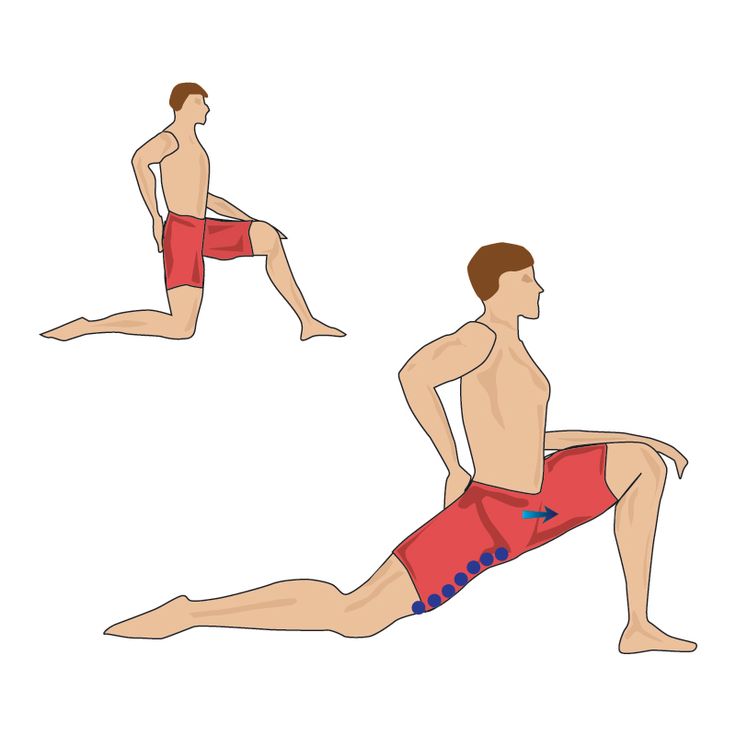
- How to perform this stretch: Kneel with your left knee on the ground, the right knee bent at a 90-degree angle in front of you, with that foot flat on the floor. Support yourself against a wall, if you need, to keep the balance.
- Maintain the spine upright and imagine the pelvis as a bucket full of water. Maintaining the pelvis in neutral position-that is, neither tilting forward nor backward-will maintain the imaginary water from spilling out.
- Lean forward with the spine still completely straight. Think of pushing the pelvis forward while still keeping its level.
- Clenching the buttock muscles while you perform may help you get a feel for the right motion.
- Pause the stretch for between 10-30 seconds, breathing normally as you perform so, then gently release and repeat on the other side. Repeat the kneeling stretch 2 to5 times on each leg.
Standing Sartorius Stretch
- How to perform this stretch: Stand on the left leg. Support yourself against a sturdy piece of equipment if necessary to keep your balance.
- Put the right heel close to the buttocks.
- Grasp the right foot in both hands if possible or in the right hand to help maintain it close to the body.
- Imagine pushing the hips forward without any arching of the back. You can feel the stretch in the front of the hip & possibly down the inner side of the thigh as well.
- Breathe normally. Pause the stretch for 15-30 seconds, then gently release and repeat on the other side.

Butterfly stretch
- How to perform this stretch: Sit down on the mat with the legs in front of you.
- Reach forward and grab the left foot. It is ok to flex the knee to help the hand and foot join.
- Slowly pull your left foot up towards the groin bending until it is at a cozy spot and the sole is facing the right thigh.
- Flex the right knee to bring your right foot toward your groin so that its sole touches the sole of the left foot.
- Grasp the feet with your hands & place your elbows on the knees.
- While keeping the back upright, allow your knees to fall toward the ground. You can give some pressure on the inner thigh by pressing slowly on the knees with the elbows.
- When you feel stretched hold it for 60 seconds.
- Repeat 3- 4 times.
Fire Log Pose
- How to perform this: In a sitting position on 1 edge of a thickly-folded blanket, knees bent, and feet on the ground. slowly shrug your shoulders up, and maintain the spine upright.
- Slide the right foot under the left leg to the outside of the left hip, and lay the outer leg on the ground. Then, stack the left leg on top of the right.
- If you have more flexibility in the hips, you can slide the right shin forward directly below the left to increase the challenge; otherwise, maintain the right heel beside the left hip. If the hips muscles are tight, you may perceive that bringing the ankle to the outer knee is uncomfortable. In this take sit with the shins crossed in the Sukhasana position.
- Press through the heels & spread the toes. Keep your front upper body long, exhale & bend forward from the groins. Tell that not to round forward from the belly. Lay the hands on the floor in front of the shins.
Standing Hip Flexor Stretch (Iliopsoas stretching)
- This stretch is beneficial for the person who cannot take the kneeling position.
- How to stretch: Stand tall with the feet around hip distance apart.
- Step the left foot forward into the split stance.
- Engage the core muscle as well as tuck the pelvis. The patient may place the hands on the left leg.
- Maintain the back leg straight as well as gently lunge forward with the left leg.
- The patient may feel a stretch in the front of the hip, groin, as well as thigh of the right side.
- Hold the lunge position for 20 to 30 seconds. The person should not feel any low back pain. If you do, release the stretch.
- Gently return to the starting position & change sides.
- Do the standing hip flexor stretch 2-3 times on each side.
Kneeling Hip Flexor Stretch
- How to stretch: Take a half-kneeling position with the left leg about two feet in front of the right leg.
- A left knee should form a 90-degree angle. The patient needs to use the mat for cushioning.
- Place the hands on the left knee, and keep an upright posture.
- After that, incline slightly forward till you feel the stretch in the front of the hip, groin, & thigh of the right side.
- Hold the kneeling position for 20 – 30 seconds. The person should not feel any low back pain. If the patient does, release the stretch.
- Slowly come back to the starting position & change sides.
- Do the kneeling hip flexor stretch 2-3 times on each side.
Hip Flexor Bed Stretch
- How to do this stretch: Lie in the supine position on the bed & position yourself with the left leg closest to the edge of the
- bed.
- Slowly let the left leg hang down to the side of a bed.
- The right leg may stay bent with the foot on the bed.
- The patient can feel the stretch in the hip flexor.
- Ideally, the foot will hover over the ground instead of touching it. But this is okay if it does touch the ground.
- Deepen the stretch by slowly bending the knee. The person should feel the across the thigh and front of the hip.
- Hold the hanging position for 20 – 30 seconds.
- Come back to the left leg of the bed & rotate so the right side is closest to the edge of the bed.
- Do the hip flexor bed stretch 2-3 times on each side.
Table Psoas Stretch
- How to stretch: Choose a table that is slightly lower than the hip level.
- Stand with the left side next to the table & lift the left leg behind you as well as put it onto a table with a knee facing down.
- The leg will be aligned. The patient may put the folded towel under the knee to relieve any pressure from a table.
- Place the left hand on the table in front of you. The right leg should be slightly flexed.
- Gently move into the stretch by raising the chest up tall as well as opening up the hip flexor area.
- Pause when you feel the stretch in the left hip.
- Hold the standing position for 20- 30 seconds.
- Let go of the stretch & repeat on the opposite side.
- Do the table psoas stretch three times on each side.
Runner’s Lunge
- How to do this stretching: Start kneeling with both knees on the ground.
- Then, bring the left foot forward so that the left knee is directly above the left ankle.
- Simultaneously extend the right leg behind you so that the right knee is behind the right hip as well as the top of the foot
- is on the floor.
- Rest the hands on the left thigh.
- For a deeper stretch, drive the top of the back foot into the ground.
- Pause for 60-120 seconds, then repeat the movement on the opposite side.
- It is one repetition. Do it 3-4 times.
Hips Elevated stretch
- How to do the stretching exercise: Lie down in the supine position with the extended in front of you & the arms at the sides.
- After that, put the foam roller or block under the hips as well as low back.
- So the hips are elevated and the head & shoulders are resting on the ground.
- Bend the right knee & wrap the arms around the shin to bring it closer to the chest.
- Hang there for 60 – 120 seconds.
- Then repeat the movement on the opposite side.
High Lunge
- How to stretch: Stand tall with the feet around shoulder-width apart and the hands at the sides.
- Step the right foot a couple of feet behind you & bend the left knee 90 degrees, so it is directly above the left
- ankle.
- Press the right toes as well as the ball of the foot into the ground and straighten the arms directly overhead.
- Hang up for one to two minutes before repeating on the opposite side.
Half Frog
- How to do this stretch: Begin lying on your stomach with the legs extended behind you.
- Rest the forehead on the back of the hands.
- Bend the left knee so that it is parallel to the left hip, as well as flex the left foot.
- The left shin should be aligned with the right leg.
- Press the left knee into the ground to bring the left inner thigh as close to the mat as possible.
- Hold for 60-120 seconds before repeating on the opposite side.
Hero Pose
- How to do this stretching: Begin kneeling with both knees on the ground.
- Then put a block or even foam roller between the feet, just below the tailbone.
- Flex the knees to lower yourself down on the block or roller.
- Maintaining the knees together & the tops of the feet pressed into the ground.
- Sit tall with the shoulders directly above the hips.
Supported Side-Plank Reach
- How to do this stretching exercise: Begin kneeling with both knees on the ground, then extend the right leg out to the side.
- Simultaneously place the left palm on the ground, directly below the left shoulder, & reach the right arm over the
- right ear.
- Your body should form a direct line from your right ankle to your right hand.
- Press the outer edge of your right foot into the floor and rotate your shoulders so they are side by side with the wall in
- front of you.
- Pause for one to two minutes, then repeat the movement on the opposite side.
Knee to chest stretch
- How to do this stretch: Lie down in the supine position with the legs extended on the floor.
- Gently bend the left knee toward the chest.
- Maintaining the back flat, pull the left knee as close to the chest as possible without discomfort.
- Stretch the right leg out as far as possible & squeeze the glute.
- Holding time is 10-15 seconds.
- Return to the starting position & repeat with the opposite leg.
Pigeon Pose
- How to do this stretching: Begin in the plank position.
- Lift the right foot off the floor and slide it forward so your knee is on the ground next to your right hand and your foot
- is near your left hand.
- Exactly where your knee and toes drop will depend on your flexibility.
- Slide your left leg back as far as you can while maintaining your hips square.
- Lower yourself to the ground and onto your elbows, bringing your torso down as far as possible.
- Hold the stretch without letting your chest drop.
- When you feel like you have gotten a good stretch, switch sides.
Standing Stance Pelvic Tilt
- How to do stretch: Stand up tall with good posture, chest pointed up as well as both shoulders back.
- Push the pelvis back & under.
- Hold the standing pose for 10 – 20 seconds.
- Release.
Cobra Stretch
- How to do stretching: Lie down in the prone position.
- Press through the hands to extend the back.
- Engage the glutes to stabilize a pelvis.
- When the patient feels stretched in front of the thigh, pause there for 10-15 seconds as well as release.
- Perform the cobra stretch 3-4 times.
Wall psoas Stretch
- How to do this stretch: Take the Lunge position in front of a wall.
- Rest your right foot on a wall.
- Drive the knee closer to a wall.
- Rotate the hips backward again.
- To lower the intensity of the stretch, drive the knee forward.
- Hold the psoas stretch for 15-20 seconds & do it 3-4 times.
Sumo Squat Stretch
- How to do this stretch: Stand tall with the feet wider apart.
- Laterally rotate the feet. The knees & toes are pointing out.
- Maintain the back straight as well as the chest facing up.
- Squat downward while maintaining the thighs facing out.
- Pause that squatting position for 10-15 seconds & perform it 2-3 times.
Lunge Stretch
How to perform stretch:
- Begin kneeling on the ground in a lunge position.
- Bend your torso forward to bring the outside of the shoulder towards the interior of the lead knee.
- Then, lunge forward so the hips slide forward.
- You can feel a stretch along the inside of the forwarding leg.
- Hold this adductor stretch for 5- 10 seconds then release.
- Perform 10-12 repetitions.
Standing Lateral Lunge Pectineus Stretch
How to perform stretch:
- Stand in a broad stance position.
- Now bend your & knee & move your hips to that side.
- maintain posterior pelvic tilt during the stretch
- You can feel a stretch inside of the opposite thigh.
- Hold for 5-10 seconds & release.
- You can enhance holding time in progression.
- Do this adductor stretch 4-5 times.
Pectineus AIS Release
How to perform stretch:
- Begin in a supine position with a resistance strap on around one foot.
- The opposite end of the strap is grasped in the hand.
- Then, actively slide the foot sideways.
- make sure to slide the foot, don’t raise it or the hip flexors can contract.
- At the end of the movement gradually pull the foot further outwards with the resistance strap.
- You can feel a stretch in the adductors.
- Hold the stretch for 5 to 10 seconds then slide to return.
- Perform 8-10 repetitions.
Supine Wall Stretch
How to perform stretch:
- In the supine position in front of a wall with the leg up on the wall.
- move towards the wall as you can, and maintain a comfortable stretch in the hamstrings.
- Maintain the leg straight while they slowly split open until you feel a stretch inner side of the legs.
- Hold the stretch for 15-30 seconds.
- Relax & repeat 3 times.
Standing Adductor Stretch
How to perform stretch:
- Start standing with the feet around 3 feet apart.
- Transfer the weight to one side & bend your knee.
- Keep the other knee straight to feel a stretch on the inside of the thigh.
- Hold the stretch for 15-30 seconds.
- Relax & repeat on the other side.
Kneeling adductor stretch
How to perform stretch:
- Begin with your knees & hands on the ground.
- Straighten out a left leg to the side. Try to keep the leg on the floor.
- Move your butt back to the heel of your right bent knee.
- You can feel the stretch on the inner thigh of the left leg.
- Pause for 8-10 seconds, then release the stretch & back in.
- Repeat 8-10 times.
Half-kneeling pectineus dips
How to perform stretch:
- Start in a half-kneeling position with the right knee on the floor & the left leg bent with the foot on the floor.
- Move the left leg out to the side as much as you can.
- Your foot might be at a right angle to your knee.
- With your hands on your hips, dip the body toward the left leg.
- You can feel the stretch on the inner thigh—especially on the right side.
- Repeat 8-10 times.
Frogger stretch
How to perform stretch:
- Start with your knees & forearms on the ground with your knees & feet wider.
- Try to keep the inner part of your feet on the floor.
- Sit the butt back to the heels, feeling the stretch on the inner thighs.
- Pause for 10-15 seconds, then release the stretch & back in.
- Repeat 8-10 times.
Lateral squat
How to perform stretch:
- Stand tall & put the feet double shoulder-width apart.
- Transfer your weight to your left leg, bend your left knee, & push your hips back as if you are taking a sitting position.
- Drop as low as possible while keeping your right leg straight.
- Keep the chest up & your weight on the left leg.
- Breathe & hold for 15 to 20 seconds prior to returning to the beginning position.
- Repeat 2-3 times, then move to the other side.
Crossover Stretch
If you love dancing, this move might come naturally as it is the same as the “grapevine” dance move.
How to perform stretch:
- Start with the feet together, then step to the right with the right foot.
- Cross your both foot.
- Step to the right again with your right foot, & bring your left foot to join your right foot.
- Once both feet are together and repeat on the opposite side.
- You can start gradually, but pick up the stride as you get used to the move.
- Do it 5-10 times.
Seated pectineusStretch
How to perform stretch:
- Straight the legs out to the side, and make a “V” shape.
- To prevent joint strain, do not overdo this pose.
- For many people, simply sitting like this is enough to give an inner thigh stretch.
- If you want to feel more stretched, keep your back straight, and lean towards the floor from your hip joints.
- Stay there for around 10-15 seconds. breathe normally.
Reclining angle bound pose
This is the best stretch if you spend most of the day in a sitting position.
How to perform stretch:
- Take a supine position on the ground.
- Bend both knees & draw your soles inward so that their borders are touching each other.
- Move the knees down toward the floor so that you can feel the groin muscles stretching.
- Breathe & hold this position for 15- 30 seconds.
- Repeat 3-4 times. Try to draw the feet closer to the buttocks with every stretch.
Hip Opener and Groin Stretch
How to perform stretch:
- Begin in a forward lunge position & drop your right knee to the floor.
- Place the left elbow on the inside of your left knee as pictured.
- Press the left elbow gently into your left knee & twist your torso to the right.
- Reach the right arm behind you until you feel a gentle stretch in the lower back & left groin.
- Hold the stretch for about 20-30 seconds, release & repeat on the right leg.
Squatting Groin Stretch
How to perform stretch:
- Take a standing position with the feet wide apart, and toes pointing outwards.
- Slowly start squatting down until your knees are directly over the ankles & bend to 90 degrees.
- Put your hands on top of your inner thighs & gently push outward to open the hips.
- You will feel the stretch in the inner side of each leg.
- Hold for 20 – 30 seconds, relax & repeat 3 times.
Frog Squat With Arm Raise
How to perform stretch:
- Moving directly from the first stretch, place the right hand on the ground.
- Continue to gradually push your inner thigh outward, as you reach the left hand directly up to the roof, fingers pointed upward.
- With each breath, twist the upper body slightly further, reaching as high as you can.
- Your right heel might lift slightly.
- Then, switch the other sides.
What are the health benefits of stretching the hip flexor muscle?
If a patient stretch properly they may gain these many benefits are:
- Good quad stretches stimulate the muscles & increase blood flow to the area.
- This also decreases rectus femoris muscle tightness and pain.
- A good stretch will make the muscle used for many physical activities namely the run, brisk walking, squats, yoga, or other sports activities.
- Rectus femoris stretching exercises increase short-term range of motion, like hip flexion as well as knee extension.
- This stretch helps you to prevent injuries while doing leg workouts.
- This increases long-term flexibility as well as mobility.
- This relieves muscle soreness.
What are the common mistakes the patient can avoid while hip flexor muscle stretching?
There are certain mistakes that the patient cannot make during stretching:
- Bouncing: Do not bounce while doing the stretch. If the patient finds himself performing so, you need to stabilize yourself by holding onto sturdy objects.
- Locking the Knee: Never lock the standing knee while the stretch. maintain it soft.
- Knee moving Outward: Do not allow the bent knee to drift outward. Maintain the knees next to each other.
- Stretching prior to Warm-up: To avoid muscle strain, the patient can stretch only after you are done with the warm-up.
- Stretching to Pain: Stretch until you feel mild discomfort, do not stretch to the point of pain. Take safety not to strain the knee. The aim is not to touch the heel to the buttock, but rather to feel the gradual stretch in the thigh.
- Arching the Back: Do not arch the low back as you bend the knee, maintain the abdominals engaged to keep the back neutral as you drag into this stretch.
Hip flexor muscle Stretching Safety Guidelines
There are certain guidelines the patient needs to follow while stretching:
- Stretching is no exception: Stretching may be dangerous & cause injury if you do it wrongly.
- Breathe: Never hold the breathing. Holding the breathing causes tension as well as stress in the muscle, & may increase blood pressure. The deeper you breathe, the more relaxed the muscles will be, and the deeper and longer you can stretch.
- Stretching tight muscles are uncomfortable for you, but the patient should never feel any stabbing or even sharp pain.
- Be consistent: Do stretching daily for a few minutes or seconds a couple of times a day that gradually builds flexibility & increases range of motion over the long term. It is a good way to stretch, rather than doing it longer times only once a week.
- Wear loose comfortable clothing, as it is tough to stretch if the clothes are tight and restrict movement.
Strengthening exercise of hip flexors
- Standing Leg Circles
- Side-Lying Hip Adduction
- Squat Side Kick
- Standing side Leg Raise
- Sumo Squat
- Cross Scissors
- Dumbbell Side Lunge
- Cossack Squat
- Copenhagen Side Plank
- Cable Hip Adductor
- Seated Hip Adduction
- Adductor machine
- Wide stance squat
- Standing banded adduction
- Seated banded adduction
- Glute Bridge
- Hips Elevated
- High Lunge
- Half Frog
- Hero Pose
- Supported Side-Plank Reach
- Lying hip rotation
- Sidekick
- Hip raises
- Leg raises
- Frankensteins
- Hanging Leg Raise
- Bridging Psoas March
- Romanian Chair Leg Raises with Dumbbell
- boat pose
- Plie Squats
- Clam Exercise
- Step-ups
- Lateral band walks
Standing Leg Circles
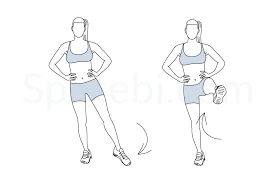
How to do it?
- This is the dynamic warm-up exercise, this exercise improves blood circulation to the hip muscle & upper leg.
- for the standing leg circle exercise, stand with feet hip-width apart.
- Raise the left leg off the floor. while balancing on the right leg, make a small circle with your left leg.
- Complete 10 to 20 repetitions on the left side then change to the right leg.
- Note: If you have a balance problem then stand close to a prop where you can help to maintain your body by holding something.

Side-Lying Hip Adduction
How to do it?
- This is the best exercise for the hip adductors that can be done on the ground while isolating a single leg at a time.
- All you need to do is to focus on contracting the hip adductor muscles to raise your leg off the floor.
- For this exercise, you have to lie down on your left side and take your arms in front of you with your elbows & forearm on the floor for support. raise the right leg over your lower leg placing your heels against the thigh of your bottom leg.
- maintain your leg extended, and raise it upward as much as possible.
- Slowly return to the starting position.
- Do 10-25 repetitions on the left side then move to the right leg.
- Note: You can add some provocation to your exercise by using a resistance band attached to an anchor or by strapping an ankle weight to the leg.

Squat Side Kick
How to do it?
- The squat side kick bodyweight exercise will utilize both the adductors & the abductors & is a great all-around lower limb exercise.
- This exercise combines 2 movements that enable both muscle strengthening & stretching which is important to decrease the risk of suffering from groin pain.
- For the Squat Side Kick exercise, you have to stand with a shoulder hip-width apart, and your hands are together in front of you.
- Flexed your knees until your thighs are parallel to the floor, then stand up & transfer your weight to your right leg while kicking out the left leg to the side.
- Back to squatting position then repeat it on another leg.
- Note: Your core muscles might be engaged throughout the movement with your back straight, and chest up, & do not let your knees extend past your toes while squatting.

Standing side Leg Raise
How to do it?
- This is the best bodyweight exercise that can hit the hip adductors of one leg while hitting the hip abductors of the other leg as you will be using an isometric hold on your other leg to maintain it in the air.
- For this exercise, you have to stand with your shoulders hip-width apart. now on the left leg away from the body.
- Then Lift the right leg as far as comfortable, & hold it there for 4-6 seconds.
- Raise your left leg to your right leg until they touch then lower back to the starting position. Complete 10-18 repetitions of 2-3 sets.
- Note: To make this exercise more challenging strap ankle weights to both legs.

Sumo Squat
How to do it?
- This variation of the squatting will hit the muscle groups in the lower limb plus the inner thighs.
- Maintain your back straight & your chest up throughout the exercise.
- Even though the sumo squat has a smaller range of motion compared with a regular squat, it is still an effective exercise that can be incorporated into normal workouts.
- For this exercise, you have to stand wider than the shoulder-width stance with your pointing outside.
- Take a squatting position, drop your hip down & back while your back is straight & chest up until your thighs are parallel to the ground.
- Push off through the ground and return to the starting position.
- Note: If you want to add some provocation to your exercise then hold a kettlebell in your hand.
Cross Scissors
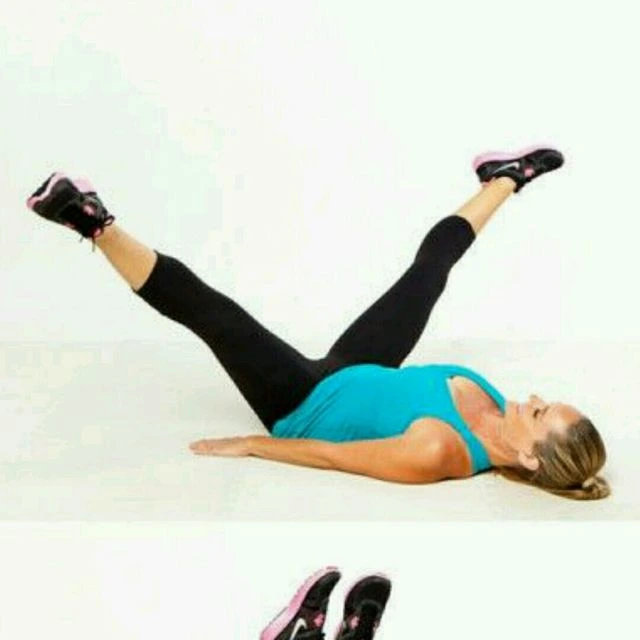
How to do it?
- This is the best exercise to work the hip adductor muscles & the core muscle simultaneously.
- Cross scissors are challenging as you require to stay in a crunched position throughout the movement.
- Maintain this position by crossing your legs in front of you need all your stabilizing muscles to be contracted.
- For this exercise, you have to Sit down & brace yourself by putting your hands on the floor back to you. move your leg off the ground in front of you at a 30-40-degree angle with one leg crossed over the other.
- Your core muscle might be engaged throughout the movement in a semi-“V” position change your legs out to the sides then bring them back closed while crossing the other leg over.
- Do this with an Alternate leg until you complete 10-20 repetitions on each side.
- Note: You can enhance the difficulty of cross scissors by sitting in a “V” position without bracing the upper limb with your arms.
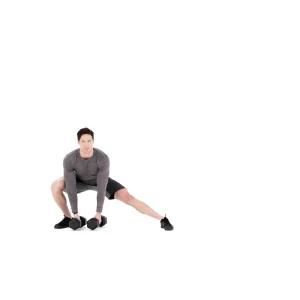
Dumbbell Side Lunge
How to do it?
- The side lunge is an excellent exercise to improve your balance, stability, & lower limb strength.
- The side-to-side movement is both a strengthening & stretching exercise. The Dumbbell Side Lunge exercise utilizes your hip abductors & hip adductor muscles.
- For this exercise, you have to stand with your shoulders hip-width apart & hold the dumbbells at your chest level.
- Take a large step to your side & drop your hip down & back until your thighs are parallel to the floor while your foot is planted on the ground.
- Push through your flexed foot, & bring your back to the initial position.
- Repeat it for 10-15 repetitions then move to the next leg.
- Note: To make this exercise easy you can do bodyweight side lunges. your back might be in a neutral position & chest up while trying not to lean forward.
Cossack Squat
How to do it?
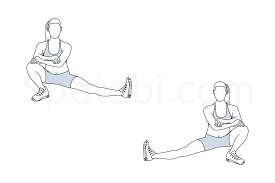
- The Cossack Squat exercise moves the body through the frontal plane of motion, going side to side.
- Working the lower limbs at this angle can improve the flexibility of hips, knees, & ankles.
- You will increase your stability by mastering this exercise by getting a good stretch & strengthening the hip adductors.
- For this exercise, you have to stand with your feet in a wide stance with toes pointing outside by dropping your hips downward & back.
- Squat down to that single side and shift your weight while your other leg is extended out with your heels on the floor, toes pointing up.
- Push through the ground with your flexed leg and bring your back to starting position.
- Repeat this exercise on the other leg by shifting the weight & lowering it down into a squat position on the other side.
- Note: Cossack Squat exercise requires a high degree of mobility so if you can not go all the way down then go as far as you can while trying to improve each workout. your back might be maintained in a neutral position throughout the exercise.
Copenhagen Side Plank
How to do it?
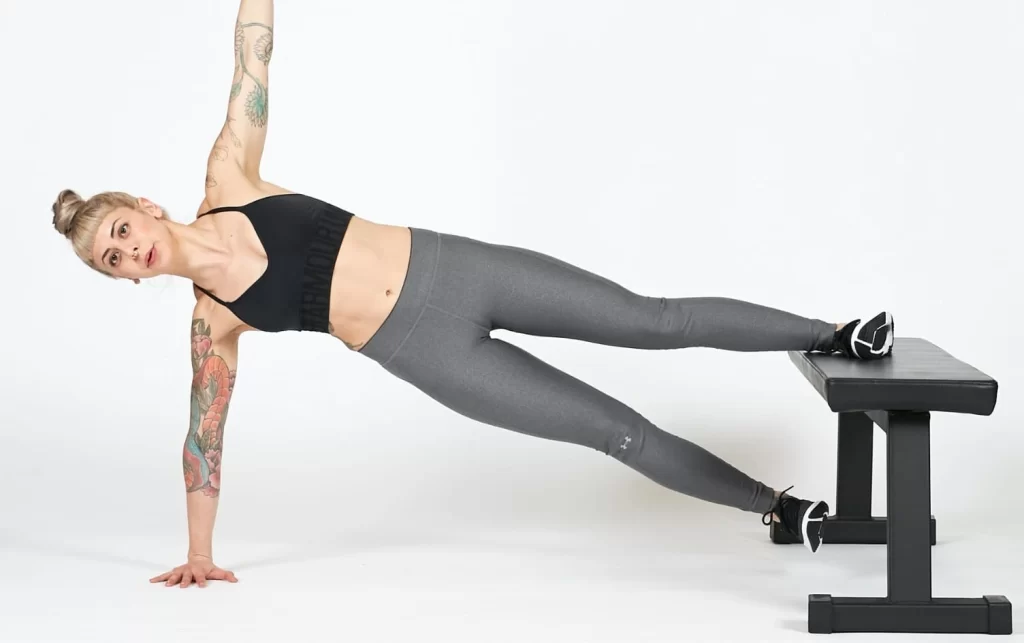
- Copenhagen Side Plank exercise is the most difficult variation of plank that not only hits the core muscles but also strengthens the hip adductors. The Copenhagen Side Plank exercise will help to balance out the strength in the muscles on the outside of the hip.
- For this exercise, you have to lie down on the floor & perpendicular to the bench then brace yourself on your forearm & elbows.
- Lift with your flexed knee lift your top leg & place it on the bench.
- Hold this position.
- Complete 20-25 repetitions for 2 sets then do this on another side.
- Note: Increase the difficulty by doing this exercise with your legs extended with only your ankle placed on the bench.
Cable Hip Adductor
How to do it?

- You may notice women at the gym doing this exercise while the men neglect it.
- It is time to move the stigma that cable hip adductions are not main, everyone might be doing this exercise to strengthen the adductors to reduce the risk of injury.
- Make sure you are warmed up with some dynamic stretches before performing this exercise then try to start with less weight & maximum repetitions until you are comfortable enough to increase the weight.
- Find an attachment that you can use to strap onto the ankle closest to the pulley.
- Set up the pulley around calve level. Stand to the side of the pulley. Brace yourself using your hand against the machine in a safe place where your fingers won’t get pinched. Your active leg might be up off the floor towards the pulley.
- Pull your leg away from the pulley towards the middle of your body.
- Slowly let the leg return to its starting position Completed the desired number of repetitions
- Note: exercise can also be done with this same technique by attaching a resistance band to a fixed anchor point.
Seated Hip Adduction
- The seated hip adduction will isolate the hip adductor muscles when you are seated, only having to focus on bringing the thighs together.
- Add a Seated Hip Adduction exercise towards the end of your leg day after completing the bigger compound lifts such as squatting.
- Seat in the machine with back against the backrest
- Set the width of the knee pads to a manageable position that gives a stretch to the inner thighs but does not over-stretch the adductor muscles.
- Set up a lightweight for the 1st time set so that you do not overdo it.
- Squeeze your thighs together while exhaling, until your knees meet in the center of the body.
- Slowly return to the initial position.
- Complete maximum repetitions.
Adductor machine
How to do it?
- Most people think of isolating the adductors, they may think of the classic adductor machine established in gyms across the world.
- Though this machine can do the best job of training the adductor, it is not the only movement that can yield good results.
- Considering that you can modify the amount of weight & width of the pads, this exercise is great for beginners. It is best to begin super light to get a feel for the exercise & avoid getting injured.
- For this exercise, you have to sit on the machine begin sitting on the machine with the pads positioned between your legs as wide as is comfortable, & select your ability-wise resistance.
- In a controlled manner, contract your thighs together just until the pads touch, & feeling the muscles contract.
- gradually reverse the movement, returning your thighs to the initial position. Repeat this exercise number of sets & repetitions.
- If just beginning, try 2–3 sets of 10 reps.

Wide stance squat
How to do it?
- Squatting is a king of leg exercises & this will stimulate the whole leg.
- There have different squat variations but here we discuss the wide stance squat also called the sumo squat which will utilize inner thigh muscles.
- You can do this exercise with a variety of weighted equipment like a barbell, kettlebell, dumbbell, or sandbag — or with just only body weight.
- For the Wide stance squat exercise, you have to stand a little wider than the shoulder hip-width apart, and turn your toes outside.
- Shift your weight backward & slowly lower your hips until your thighs are parallel to the ground.
- Then return to the starting position by pushing through the ground, and your inner thigh muscles are contracted.
- Do 10-15 repetitions of 2-3 sets.
Standing banded adduction
How to do it?
- For this exercise, you need a resistance band, and wrap a resistance band on a solid anchor. you have to stand on either side of the body facing the anchor point & the resistance band.
- Allow the resistance band to pull the leg to the side by resisting the movement.
- To start this exercise you have to stand tall & bring a banded leg towards the midline of the body, you feel the good contraction in your inner thighs.
- Gradually release your leg back to the side with control movement.
- Switch the legs & do 10 to 20 repetitions for 3 to 4 sets on each leg.

Seated banded adduction
How to do it?
- For the Seated banded adduction exercise you need a resistance band, and wrap a resistance band on a solid anchor.
- You have to sit on the bench on either side of your body facing the anchor point & the resistance band.
- Put the internal foot through the resistance band, the band is positioned just below the knee joint. allow the resistance band to pull the leg toward the anchor point.
- Move your leg towards the center of the body by contracting the adductor muscle.
- Repeat this on each leg.
- Do 2-3 sets of 12-15 repetitions.

Lateral Lunge
How to do it?
- For the Lateral lunge exercise, you have to stand with feet hip-width apart. step out of your left leg & start by sending your hip back as you flex your left knee.
- You can extend your arms forward for counterbalance if you like. during the descent, the knee should not move more than 2 inches beyond your toes, &your knee should be aligned between 2 & 3 toes.
- The toe turns outwards slightly. push-off through left to return to a starting position.
- Repeat on the right side leg to complete the 1st repetitions.
- Do 3 to4 sets of 8 to 10 repetitions on each leg.
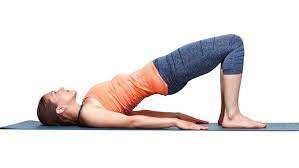
Glute Bridge:
- You are lying on your back with your arms at your sides knees bent & feet flat on the floor.
- Then Engage your glutes muscle & lift your hip joint to create a bridge between your shoulders & knees.
- Raise your hip joint till your feel a stretch in the iliopsoas muscle in both legs.
- When you feel lower back pain then lower your hip joint slightly, but must keep your glutes muscle tight.
- Hold this stretching position for 20 to 30 seconds.
- Then Slowly return to the starting position.
- Perform this exercise 10 times in 1 session & perform 3 sessions per day.
Hips Elevated:
- You are lying on your back with your legs straight out in front of you & your arms at your sides.
- Then, place a foam roller & block under your hip joint & low back so that your hip joint is elevated
- Must keep your shoulder joint & head resting on the ground.
- Then Bend your left knee & wrap your arms around your shin to bring it closer to your chest.
- Hold for this exercise 10 seconds.
- Then Slowly return to the starting position & repeat on the opposite side.
- Perform this exercise 10 times in 1 session & perform 3 sessions per day.
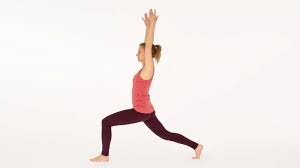
High Lunge:
- You are standing with your feet shoulder-width apart & your hands at your sides.
- Step your left foot a couple of feet behind you & bend your right knee joint at 90 degrees, so it is directly above your right ankle joint.
- Press your left toe & the ball of your foot into the ground.
- Then extend your arms directly overhead.
- Hold for this exercise 10 seconds.
- Then Slowly return to the starting position & repeat on the opposite side.
- Perform this exercise 10 times in 1 session & perform 3 sessions per day.
Half Frog:
- Start this exercise by lying on your stomach with your legs stretched out behind you.
- Rest your forehead on the back of your hands.
- Bend your right knee joint so that it stays parallel to your right hip joint & flex your right foot.
- Must be placed on Your right shin parallel to your left leg.
- Then Press your right knee joint into the ground to bring your right inner thigh as close to the mat as possible.
- Hold for this exercise 10 seconds.
- Then Slowly return to the starting position & repeat on the opposite side.
- Perform this pose 5 times in 1 session & perform 3 sessions per day.

Hero Pose:
- This exercise is Start with a kneeling position with both knee joints on the ground.
- Place a block & foam roller between your feet, just under your tailbone.
- Bend your knee joint to lower yourself down on the block & roller.
- Must be Keep your knees joint together & the tops of your feet pressed into the ground.
- You are sitting tall with your shoulder joint directly above your hip joint.
- For a deeper stretch in this pose, walk your hands behind you with fingers facing your toes & lean back slightly.
- Then Hold this pose for one to two minutes.
- Perform this pose 5 times in 1 session & perform 3 sessions per day.
Supported Side-Plank Reach:
- This exercise is to Start with a kneeling position & both knees on the ground, then extend your left leg out to the side.
- Place your right palm on the ground, directly below your right shoulder joint.
- Try to reach your left arm over your left ear.
- Keep Your body in a form a straight line from your left ankle joint to your left hand.
- Then Press the outer edge of your left foot into the ground & rotate your shoulder joint so that they are parallel to the wall in front of you.
- Hold this exercise position for 10 seconds & repeat the movement on the opposite side.
- Perform this exercise 10 times in 1 session & perform 3 sessions per day.

Lying trunk rotation:
- You are lying on the floor with your feet flat & knee joints bent.
- Then Lay one ankle joint across the other knee joint.
- Rotate the hip joint in & out.
- Hold this exercise position for 10 seconds
- Perform this exercise 10 times in 1 session & perform 3 sessions per day.
Sidekick:
- You are in a Standing position & raise one leg out to the side.
- Do this exercise on both sides & repeat between 10 times per side.
- When the strength increases, try adding light weights to the ankle joint.
- You are also Holding onto a wall for balance if you need it.
- Hold this exercise position for 10 seconds
- Perform this exercise 10 times in 1 session & perform 3 sessions per day.
Hip raises:
- You are lying on the ground with both feet planted on the floor near the buttocks.
- Then try to Raise your leg straight up must keep your thigh parallel.
- Raise the hip joint off the ground.
- Hold this exercise position for 10 seconds
- Perform this exercise 10 times in 1 session & perform 3 sessions per day.
Leg raises:
- Place your both hands & knee joints on the floor.
- Then Raise one foot back towards the sky & return to all fours.
- Hold this exercise position for 10 seconds
- Perform this exercise 10 times in 1 session & perform 3 sessions per day.
Frankenstein

- You are Standing up straight with your arms by your side & step forward with your left foot.
- Try to Swing your leg in the air as high as possible without arching your back.
- Then reach forward with your left hand to touch your right foot.
- Hold this exercise position for 10 seconds
- Perform this exercise 10 times in 1 session & perform 3 sessions per day.
Hanging Leg Raise
- First Hang from a pull-up bar that is high enough so that your feet do not touch the ground when the legs are extended.
- With a firm overhand grip try to flex your hip joint & knee joint simultaneously as you draw your legs out & up towards your chest without using the momentum.
- Then Slowly return to the starting position &repeat.
- Hold this exercise position for 10 seconds
- Perform this exercise 10 times in 1 session & perform 3 sessions per day.
Bridging Psoas March
- First Loop a mini band around the balls of your feet.
- Then place your heels on an elevated surface with your toes pointed up with your body straight.
- Try to Lift your hip joint, and engage your core & glute muscles.
- Try to bring one knee towards your chest but must keep the other leg straight.
- Must be Avoid the hip joint sagging your butt.
- Then Return to the working leg slowly & repeat on the other side.
- Hold this exercise position for 10 seconds
- Perform this exercise 10 times in 1 session & perform 3 sessions per day.
Romanian Chair Leg Raises with Dumbbell
- First, take to Position yourself in the Roman chair with a light dumbbell securely between your feet.
- Must be Keep your torso upright & press the lower back against the backrest while your forearms rest on the pad.
- Try to Lift your legs to parallel to the floor by flexing at the hip joint while keeping your knee joint straight.
- Then Slowly reverse to the starting position & repeat.
- Hold this exercise position for 10 seconds
- Perform this exercise 10 times in 1 session & perform 3 sessions per day.
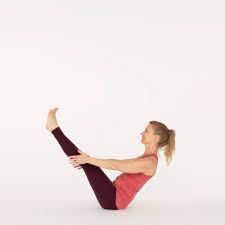
Boat Pose:
- You are sitting on a mat with your torso upright, knee joint bent & feet flat on the ground.
- Lean back slowly & tucking your tailbone under so that you are not putting pressure on it.
- While you leaning back try to extend your legs into the air & get your spine in a neutral position by eliminating the arching in your spine.
- Lift your chest &must keep your shoulders down & hold for time.
- Hold this pose for one to two minutes.
- Perform this pose 5 times in 1 session & perform 3 sessions per day.
Lunge:
- This exercise is start in a standing position, look straight ahead & take a generous step forward with your right foot.
- Must be Keep your trunk upright throughout the movement.
- Then Bend your extended knee joint & transfer your weight onto your right leg.
- Try to lower yourself slowly into the lunge till your left knee joint is on the floor.
- Your right knee joint should be directly above your right ankle joint.
- Then Step back into a standing position & Repeat with your left leg in front.
- Hold this exercise position for 10 seconds
- Perform this exercise 10 times in 1 session & perform 3 sessions per day.
Plie Squats
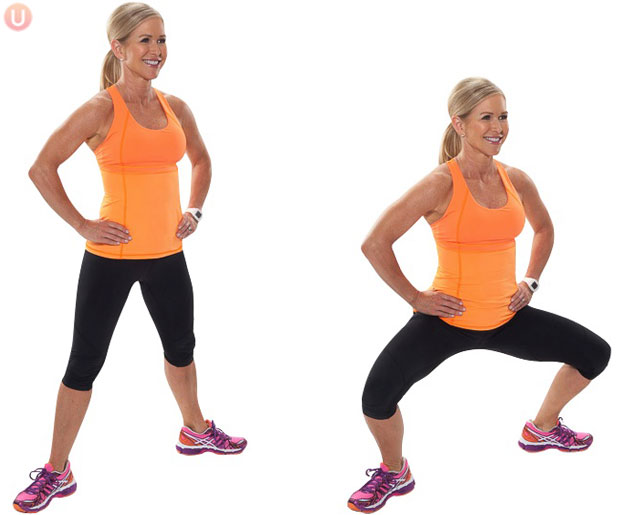
- For the Plie Squats first abduct the hip joint by creating a wide base of support, stepping the feet out laterally from the midline.
- Then rotate the hip joint outward, so that the thighs, knees & feet point toward the sides of the room.
- Bend the knee & hip joint lowering the glutes muscle straight down while keeping the hip joint externally rotated so that the knee joint remains aligned with the toes.
- When the knee joint form a 90-degree angle, press the heels & return to the standing position.
- This exercise is performed to 10 repetitions in 1 session.
- This exercise is also done with dumbbells & a barbell to increase the resistance.
Clam Exercise
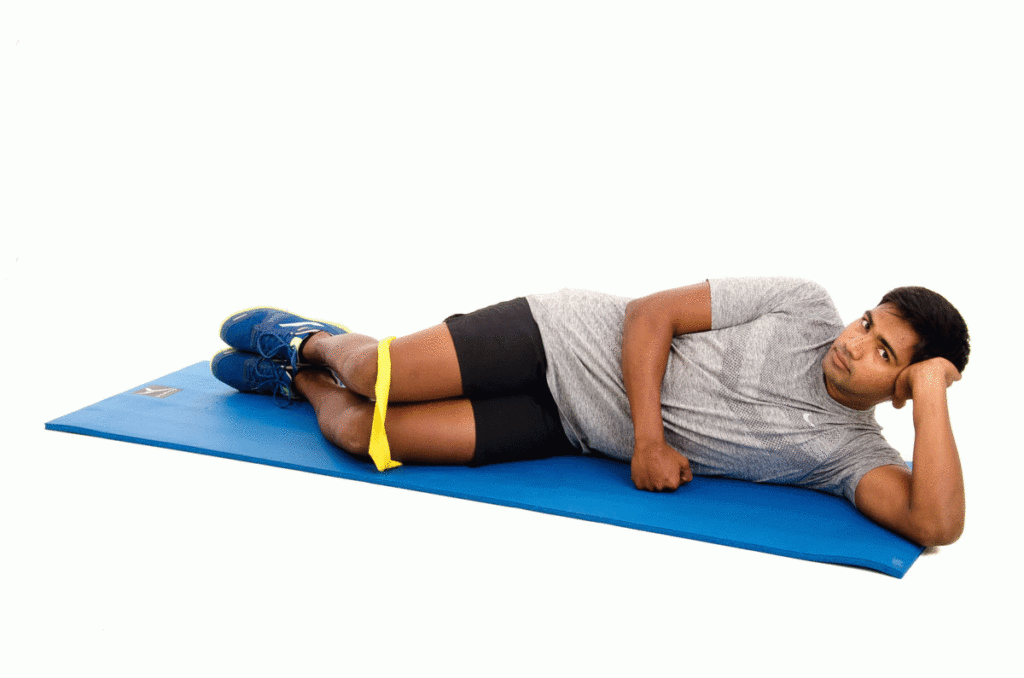
- The patient is lying on the affected side & bottom the arm extended upward to support the head & neck.
- Flex the hip & knee joints so that the thighs are positioned at a 90-degree angle to the torso & knees are also bent at roughly 90 degrees.
- Make sure the shoulder joint, hip joint & knee joint are stacked, and the body is perpendicular to the floor.
- Keep the big toes touching, tighten the core muscle & externally rotate the hip joint & knee joints open, as though the clam opening up.
- Rotate as far as comfortably with good form, then reverse the movement of exercise means, internally rotating the hip joint back into the starting position.
- Perform this exercise in 10 repetitions before repeating it on the opposite side.
- For the resistance used a small looped resistance band in the exercise.

Step-ups
- The starting position for the test is the standing position.
- Place one foot onto a platform, or step bench /to the lowest step of the staircase.
- The patient must be kept straight onto the pelvis level.
- Bend to the knee joint then slowly lower to the opposite foot onto the floor.
- Lightly touch the toe onto the floor, then rise to back up the position.
- Repeat this Step-ups exercise 10 times in 1 session & 3 sessions per day.
- This Step-up exercise targets almost all the muscles of the lower body but mostly the sartorius muscle.
Lateral band walks:
- For this exercise, used one prop-looped resistance band.
- The patient places the band around the legs, above the ankle joint.
- Then Bend both legs slightly & move the right leg laterally.
- Pull the band against the resistance & move the left leg closer.
- Then Take at least 10-12 steps in the right direction in the same way.
- Repeat this exercise with the other side.
Yoga poses of hip flexor muscle
- Crescent Lunge
- Sugarcane Pose
- Dancer’s Pose
- Little Thunderbolt Pose.
- Reclining Hero Pose (Supta Virasana)
- Half-Reclining Hero Pose (Ardha Supta Virasana)
- Bow Pose (Dhanurasana)
- Camel Pose (Ustrasana)
- Firefly Pose (Tittibhasana)
- Low Lunge (Anjaneyasana)
- One-Legged King Pigeon Pose
- Tree pose
High Crescent Lunge

- How to stretch: Take the lunge position on the ground.
- Put one knee forward around 90 degrees bend, one leg behind straight.
- After that, raise both hands overhead & clasp them together.
- Now push the hip forward & downward, and keep the back straight.
- Now slowly lean back to feel the stretch into the quads.
- The patient can feel the stretch on the backward leg.
- Holding time is around 20 – 30 seconds & repeat 2-3 times on both sides.
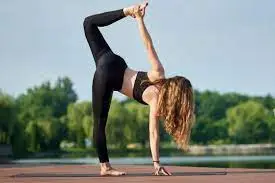
Sugarcane Pose
- How to stretch: Stand tall with the feet wide apart.
- Now raise both hands on the sides at shoulder level.
- After that, lift one leg, bend at the knee & hold that ankle with the corresponding hand.
- Now bend at the waist & put the other hand on the floor, at the side, or in front of you.
- If the patient feels stretched, then hold for 20-30 seconds.
- Repeat 2-3 times.
Dancer’s pose
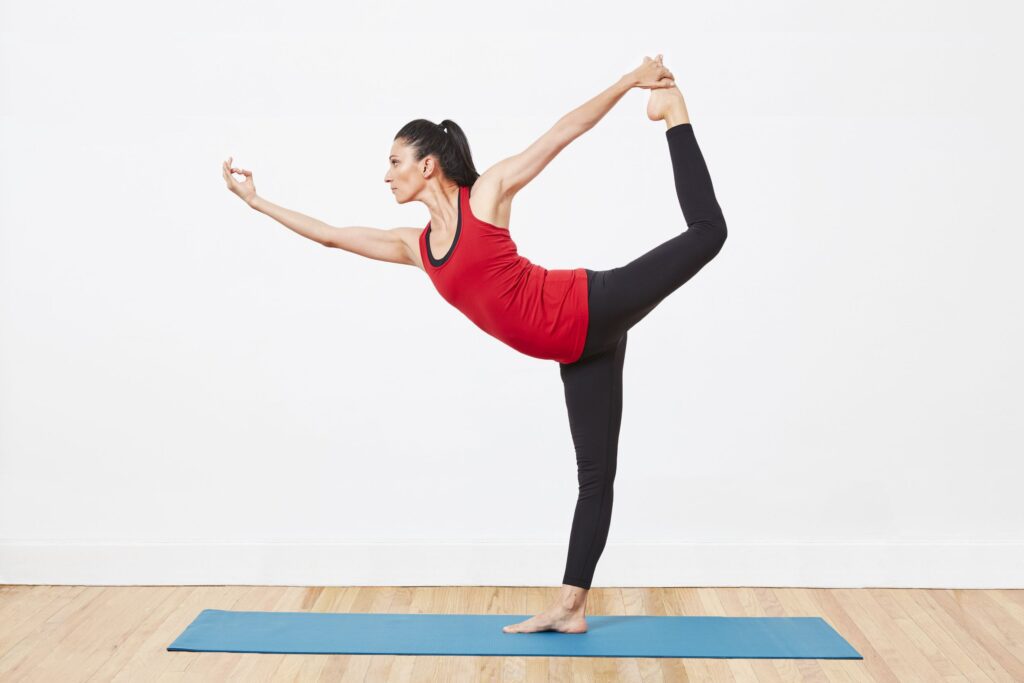
- How to stretch: Stand tall as well as feet wide apart.
- Now raise both hands forward at shoulder level.
- Raise one leg behind you & grasp that ankle with the corresponding hand.
- Now lift that leg upward behind you.
- Hold this stretching pose for at least 10-15 seconds.
- Perform 2 – 3 times.
Little thunderbolt pose
- How to stretch: Take the kneeling position on the mat.
- Now raise both hands upwards & hold the ankle.
- Slowly backward bend at the waist & try to put the head between both heels.
- Maintain the pose for 10-15 seconds to feel stretched on both quads.
- Gently release & do it 3-4 times.
Supta Virasana (Reclining Hero Pose)
- The patient is first to Perform Virasana means Exhale & lower the back torso toward the floor.
- The patient is First to lean onto the hands, then the forearms & elbow joints.
- Once the hand is on the elbow joint, place the hands on the back of the pelvis & release the lower back & upper buttocks by spreading the flesh down toward the tailbone.
- Then Sink the heads of the thighbones deep into the back of the hip joint sockets.
- It is alright to lift the knee joint a little away from the floor to help soften the groins
- The patient is also raising the knee joint a few inches with a help of a thickly folded blanket.
- In To begin position, stay in this pose for 30 seconds to 1 minute.
- Then Gradually extend the time & try to stay in the yoga pose for 5 minutes.
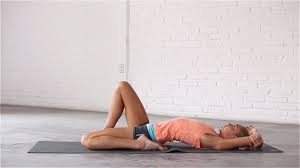
Ardha Supta Virasana (Half-Reclining Hero Pose)
- The patient is in a kneeling position towards the front of the mat.
- Bring the right foot flat to the mat & drop down inside the left foot.
- Walk the right foot out to the right as far as the patient needs to so that both sitting bones are flat on the mat.
- Check the left foot & toes point straight back& that the right knee points straight ahead.
- Place the hands behind, palms down & fingertips facing forwards & lean back till the feel the stretch in the left quad.
- The patient is come down onto the elbows or lowers the down to the mat, brings the arms up overhead & holds onto the opposite elbow joint.
- To increase the intensity, the patient hugs the right knee into the chest.
- The patient holds this pose for 3-5 slow breaths.
- Then Release the arms, bring the hands to the mat & carefully press the back up for the other side.
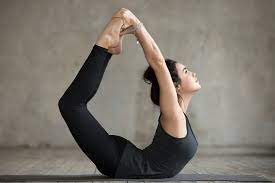
Dhanurasana (Bow pose)
- The patient is lying on the belly on the mat, with a blanket under the pelvis.
- Press all of the toes into the floor & then bend the knee joint, must keep the toes active.
- Grab the outer edges of the ankles with the hands & flex the feet strongly.
- During the inhalation, lift the rib cage & shoulders toward the ears.
- During the exhalation lengthen the tailbone & kick the legs back into the hands as they hold on firmly.
- Then lift the head & heart.
- Press down through the thighs to lift the chest.
- The patient is stay in the pose for 30 seconds.

Ustrasana (Camel Pose) :
- The patient is in a Kneeling position on the mat with both knees shoulder-width apart.
- Then Reach to the back & place the hands on to the bottoms of the feet.
- The patient becomes an Arch into a backbend
- So that the head is falling back & gazing at the wall behind the body.
- Hold this yoga pose for 30 seconds & repeat for several times.
Tittibhasana (Firefly Pose)
- Start with a Standing Forward Bend, with the toes pointing slightly out toes & the knees slightly bent.
- Take the right hand through the legs to clasp the right calf, placing the right shoulder behind the right knee.
- Then place the right hand on the floor behind the heel with fingers facing forward.
- Repeat this pose on the left side.
- Tilt the chest forward & carefully lower the legs onto the backs of the upper arms.
- Inhale, lift the feet off the mat & straighten the legs.
- The patient’s feet are pointed/flexed.
- Hold this yoga pose for 15 seconds & for a longer time, then release the feet to the floor with an exhale.

One-Legged King Pigeon Pose
- Starting on the hands & knees, slide the left knee forward, angling the left shin under the torso so that the left foot is at the front of the right knee & the outside of the left shin is resting on the floor.
- Slowly slide the right leg back, straightening the knee & resting the top of the thigh on the floor.
- Lower the outer left backside to the floor.
- Position the left heel just in front of the right hip joint.
- left knee is an angle slightly to the left, outside the line of the hip joint.
- Look back at the right leg. It extends the straight back from the hip joint.
- Lift the torso away from the thigh.
- Lengthen the lower back by pressing the tailbone down & forward.
- Draw the right front hip point slightly forward, toward the left heel.
- Stay in the pose for a few breaths, release the hands one by one & lower the torso over the left leg & down to the floor.
- The patient is held for a few breaths & repeats with the other side.

Tree pose
- This yoga pose is also known as the Vrksasana.
- The patient is standing in the Tadasana position means Spreading the toes, pressing the feet into the mat & firm the leg muscles.
- Then Raise the front hip points toward the lower ribs which are gently lifted in the lower belly.
- The patient inhales deeply, lifting the chest & exhales as they draw the shoulder blades down the back.
- The patient is looking straight ahead.
- Place the hands on the hip joint & raise the right foot high onto the left thigh or shin.
- Avoid making contact with the knee joint.
- Press the right foot & left leg with each other.
- Hold this yoga pose for several breaths, then step back into Mountain Pose & repeat this yoga pose on the other side.
FAQ
The hip flexors muscle help balance the posterior pelvic muscles. Three key muscles also become tight & shortened as a result of activities of daily living. These are the 5 muscles iliacus, psoas major, & rectus femoris.
You will feel a hip flexor strain in the anterior area where the thigh meets your hip. Mild pain & pulling in the front of the hip. Cramping & sharp pain.
The hip flexors are a group of muscles, the iliacus, psoas significant muscles also known as the iliopsoas, & the rectus femoris, a part of the quadriceps. The quadriceps runs down from the hip joint to the knee joint.
The 5 key hip flexor muscles include the iliacus, pectineus, psoas major, rectus femoris, & sartorius, which work together to enable hip flexion.
The most significant hip flexor muscle is the iliopsoas muscle. It arises to the front of the lower back vertebrae & the inside surface of the pelvis & runs through the pelvis, & attaches to the top of the thigh bone. When the muscle contracts, it flexes the hip joint into a marching position.

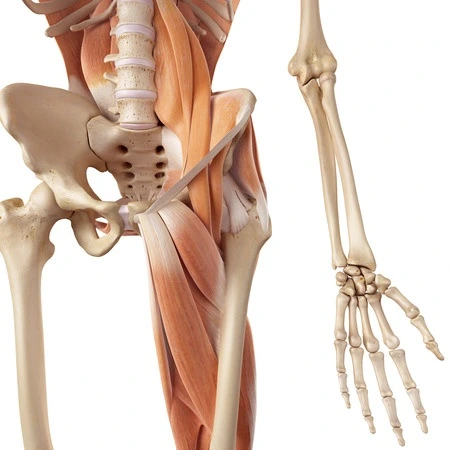
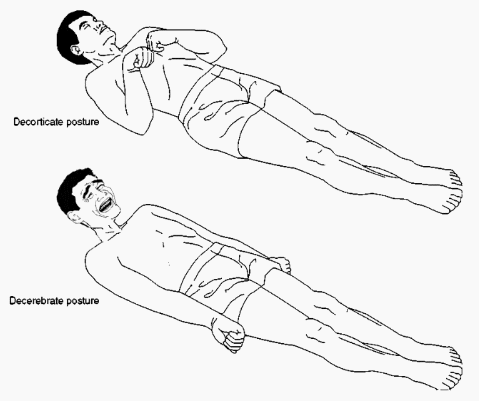
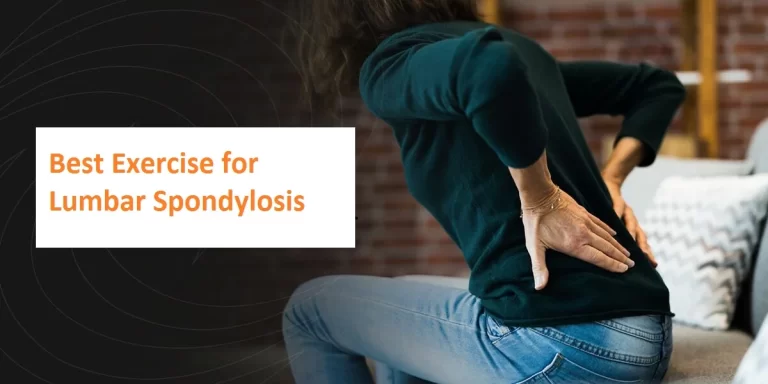
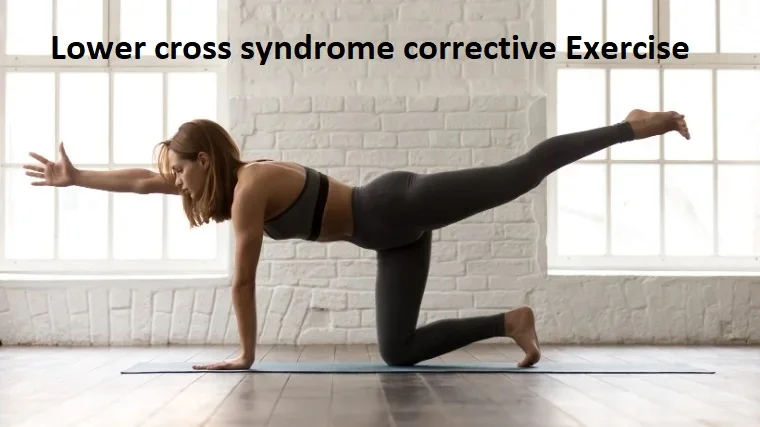
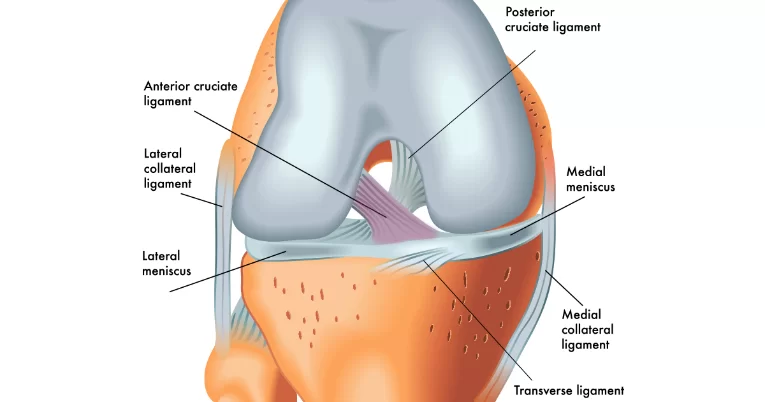
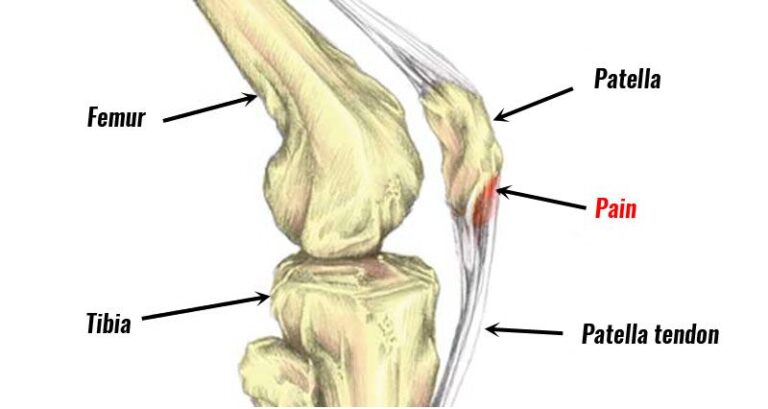
One Comment